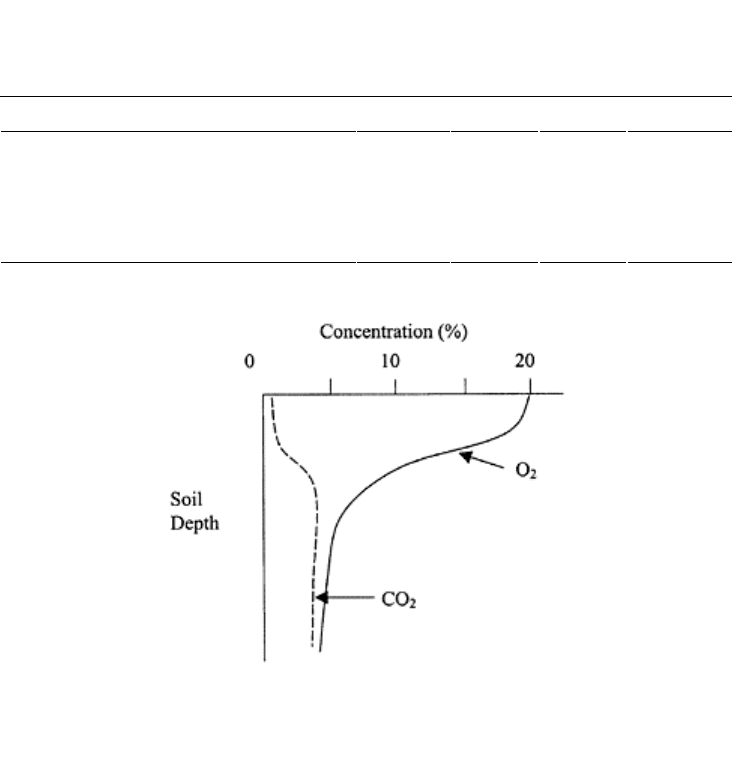Lal R., Shukla M.K. Principles of Soil Physics
Подождите немного. Документ загружается.


Nakshabandi G.A. and Kohnke H. (1965). Thermal conductivity and diffusivity of soils as related
to moisture tension and other physical properties.
Scott H.D. (2000). Soil physics agricultural and environmental applications. Iowa State University
Press, Ames, IA.
Soil Science Society of America (1987). Glossary of soil science terms. Madison, WI.
van Duin R.H.A. (1963). The influence of soil management on the temperature wave near the
surface. Technical Bulletin 29, Institute of Land and Water Management Research,
Wageningen.
Weast R.C. et al., eds. (1989). Handbook of Chemistry and Physics. Boca Raton, Florida, CRC
Press, 69th edition.
WHO (1979). Environmental health criteria 14: Ultraviolet radiation. WHO, Geneva, Switzerland.
110pp.
Principles of soil physics 514

18
Soil Air and Aeration
18.1 AIR
Earth is surrounded by a gaseous envelope of air about 80 km thick called the
atmosphere. The origin of Earth’s atmosphere is still a subject of speculation. One theory
seems fairly certain that some five billion years ago when Earth was formed, it was
extremely hot and did not have an atmosphere. It is generally accepted that the first
atmosphere, created when Earth cooled down, consisted of helium (He), hydrogen (H
2
),
ammonia (NH
3
), and methane (CH
4
). Assuming that five billion years ago volcanoes
emitted similar gasses as in the modern era, Earth’s second atmosphere probably
consisted of water vapor (H
2
O), carbon dioxide (CO
2
), and nitrogen (N
2
), because these
gasses are emitted from Earth’s interior by a process known as “outgassing.” With
colonization by plants, which absorb CO
2
and emit O
2
during photosynthesis, the
atmosphere eventually contained a large concentration of O
2
, which now constitutes one-
fifth of its volume.
In fact, the envelope of air is a mixture of many discrete gases. Each gas has a distinct
physical and chemical property. The atmosphere com prises two types of gases: those
whose concentration remains essentially constant or permanent (by percent), and those
that are variable and have changing concentrations over a finite period of time. Among
the permanent gases, nitrogen (78.1%) and oxygen (20.9%) constitute about 99% of the
atmosphere. Other permanent gases are argon (Ar, 0.9%), neon (Ne, 0.002%), helium
(He, 0.0005%), krypton (Kr, 0.0001%), and hydrogen (H
2
, 0.00005%). The variable
gases are water vapor (H
2
O, 0 to 4%), carbon dioxide (CO
2
, 0.037%), methane (CH
4
,
0.0002%), ozone (O
3
, 0.000004%), and nitrous oxide (N
2
O, 0.00009%)
(www.met.fsu.edu/explores/atmcomp.html). A brief description on some of these gases is
given in the following sections.
18.1.1 Nitrogen
Nitrogen gas (N
2
) is composed of molecules of two nitrogen atoms, and occupies 78.1%
of Earth’s atmosphere. It is colorless, odorless, and tasteless. The atomic weight of N
2
is
14. Nitrogen is a principal nutrient. The low content of nitrogen in most soils exists in
stark contrast to its abundance in the air. This is because gaseous N
2
molecules have very
strong bonds, which make the gas chemically stable, but unusable by most biological

organisms. Some species of bacteria absorb N
2
from the air and convert it to ammonium,
which can be used by plants. This process is called “biological nitrogen fixation” and is
the principal natural means by which atmospheric nitrogen is added to the soil by
nitrogen-fixing bacteria living in nodules on the plant roots. An example of a leguminous
nitrogen-fixing crop is soybean (Glycine max).
18.1.2 Oxygen
Oxygen gas (O
2
) is composed of molecules of two oxygen atoms, and occupies 20.9% of
Earth’s atmosphere by volume. It is colorless, odorless, and tasteless, and constitutes 86%
of the oceans and 60% of the human body. It is the third most abundant element found in
the Sun. The atomic weight of oxygen is 16. Almost all plants and animals require
oxygen for respiration to maintain life. Oxygen is flammable, reactive, and oxidizes most
elements. A chemical reaction in which an oxide is formed is known as “oxidation.” The
rate at which oxidation occurs varies with the element with which oxygen is reacting,
(e.g., burning involves a rapid oxidation, whereas rust, or iron oxide, forms slowly).
Carbon in fossil fuels, for example, can be quickly oxidized to carbon monoxide (CO)
and carbon dioxide (CO
2
), with a considerable amount of heat being given off. Within the
stratosphere (the second major layer of the atmosphere, which occupies the region of the
atmosphere from about 12 to 50 km above Earth), O
2
molecules combine with free
oxygen atoms to form ozone (O
3
). It absorbs ultraviolet (UV) radiation from the Sun.
18.1.3 Trace Gases
Oxygen and nitrogen together constitute about 99% of the atmosphere, and the remaining
1 % is made up of trace gases whose concentrations are very small. The most abundant of
the trace gases is the noble gas argon (atomic weight=39.9). Noble gases, which also
include neon (20.2), helium (4), krypton (83.8), and xenon (131.3), are very inert and do
not generally involve any chemical transformation within the atmosphere. Hydrogen
(1.008) is also present in trace quantities in the atmosphere. Although low in
concentrations, the important trace gases in Earth’s atmosphere are the so-called
“greenhouse gases.” These greenhouse gases include carbon dioxide (44), methane (16),
nitrous oxide (44), water vapor (18), ozone (48), and sulfur hexafluoride (SF
6
, 146.1).
These gases allow sunlight, which is radiated in the visible and ultraviolet spectra, to
enter the atmosphere unimpeded, but prevent most of the outgoing infrared radiation
from the surface and lower atmosphere from escaping into outer space. The greenhouse
gases absorb reflected infrared radiations (heat), thus trapping the heat in the atmosphere.
Thus, these gases keep Earth warm through the so-called natural “greenhouse effect,”
which has raised Earth’s temperature from −18°C to 15°C, an increase of 33°C. (Refer to
the footnote on p. 532.)
Variable greenhouse gases, can be divided into two categories: (i) those that occur
naturally in the atmosphere (e.g., water vapor, CO
2
, CH
4
, and N
2
O) and (ii) those that
result from human activities (e.g., chlorofluorocarbons (CFCs), hydrofluorocarbons
(HFCs), perfluorocarbons (PFCs), and sulfur hexafluoride). Human activities can also
enhance the concentration of naturally occurring greenhouse gases. Each greenhouse gas
differs in its ability to absorb heat in the atmosphere, and HFCs and PFCs are the most
Principles of soil physics 516

heat-absorbent. The atmospheric lifetime of CH
4
, a greenhouse gas 21 times more
effective than CO
2
in trapping its long-wave radiation, is approximately ten years.
Methane (CH
4
) can trap 21 times more long wave radiation per molecule than CO
2
, and
N
2
O can absorb 310 times more long wave radiation per molecule than CO
2
(IPCC,
2001). Methane, in contrast to CO
2
and other greenhouse gases, has the unique property
of being partly converted to H
2
O by cosmic radiation in the mesosphere.
The global mean surface air temperature has increased between approximately 0.3 and
0.6°C during twentieth century (IPCC, 2001). Globally, sea level has risen 10–20 cm
over the past century. Worldwide precipitation over land has increased by about one
percent. The frequency of extreme rainfall events has increased throughout much of the
TABLE 18.1 Concentration of Some of the
Atmospheric Gases in 1 cm
3
Volume
Gas Formula Volume
(gmol−1)
Concentration
(% vol.)
Molar mass
(gmol
−1
)
Concentration
(g cm
−3
)
Nitrogen N
2
22.4 78 28 9.75×10
−4a
Oxygen O
2
22.4 21 32 3.0×10
−4
Carbon dioxide CO
2
22.4 0.033 44 6.0×10
−6
Methane CH
4
22.4 0.0002 18 1.6×10
−9
United States (IPCC, 2001). Some of the sinks, which absorb CO
2
, are oceans, soils, and
trees. Each year those sinks absorb hundreds of billions of tons of carbon in the form of
CO
2
. Concentration of trace/greenhouse gases in the atmosphere is also highly variable
over time and space. Gaseous concentration is expressed on the basis of density or gL
−1
,
and can be calculated using Avogadro’s law (see the footnote to Table 18.1).
Avogadro’s law (1811) states, “Identical volumes of any gas at a standard identical
temperature and pressure contain the equal number of molecules regardless of their
chemical nature and physical properties.” This number, known as “Avogadro’s number”
(N′), is 6.023×10
23
. It is the number of molecules of any gas present in a volume of 22.41
L and is the same for a very light gas (e.g., H
2
) as for a heavy gas (e.g., CO
2
or Bromine,
Br). Avogadro’s number is now considered to be the number of atoms present in 12
grams of the carbon-12 isotope (one mole of carbon is 12 g).
The concentration of atmospheric gases in a 1 cm
3
volume, can be calculated from the
fact that a gram molecular weight of a gas occupies 22.4L of volume at standard
temperature and pressure (STP). Thus, the concentration of O
2
in the atmosphere is
3×10
−4
gcm
−3
. Similarly, the atmospheric concentration of other gases can be computed
(Tables 18.1).
Soil air and aeration 517

18.2 SOIL AIR
Soil air refers to air in the soil. It is located in the air porosity, whose volume is inversely
proportional to that of the soil water Thus, as the volume of soil water (θ)
increases, that of soil air (f
a
) decreases, and vice versa. A compacted soil or an undrained
soil has smaller amounts of soil air than a well-structured and drained soil. In a well-
structured soil the soil air content is higher with soil air occupying most of the large or
macropores. In general, soil air content (f
a
) and water content (θ) are nearly equal at field
moisture capacity for well-structured soils. The increase in bulk density (ρ
b
) decreases the
total porosity (f
t
) and for given water content (θ) decreases the soil air content (f
a
). Soil
air content is also affected by drainage conditions in the field as poor or improper
drainage increases the water content of soil thus lowering the air content. Composition of
soil air is highly variable and depends on numerous factors (e.g., soil structure, bulk
density, drainage conditions). In a well-aerated soil, the oxygen content of soil air is
similar to that of the atmosphere because the consumed O
2
is readily replaced and CO
2
generated is readily removed from the soil-air system. In soils with restricted exchange,
soil air differs from atmospheric air in several respects. The CO
2
concentration in soil air
is much higher and O
2
concentration much lower than atmospheric air. Soil air is also
relatively moister than atmospheric air, and it contains numerous trace gases (e.g., H
2
S).
The composition of soil air varies greatly from place to place in the soil, as plants
consume some gases and microbial processes release others (Tables 18.2 and 18.3). The
amount and composition of soil air is determined by the water content of soil unless the
soil is very dry. The O
2
content in a well-aerated soil is higher than that of a poorly
aerated soil. The latter has higher concentrations of CO
2
, CH
4
, and N
2
O than atmospheric
air. As the depth of soil profile increases, the concentration of CO
2
increases with a
corres-ponding decrease in O
2
concentration; however, the sum of these two
TABLE 18.2 Measured O
2
and CO
2
Content in Soil
Air (% by Volume) at Two Depths
0
2
(%) CO
2
(%)
Soil management 15 cm 46 cm 15 cm 46 cm
Arable land manured 20.52 20.33 0.34 0.50
Arable land unmanured 20.32 20.35 0.34 0.45
Grassland 18.44 17.87 1.46 1.64
Source: Modified from Russel and Appleyard, 1915.
Principles of soil physics 518

TABLE 18.3 Measured O
2
and CO
2
Content (% by
Volume) in Soil Air Collected During Summer and
Winter
Cropping systems
O
2
(%) N
2
(%) CO
2
(%)
Arable land manured and cropped Summer 20.74 79.03 0.23
Winter 20.31 79.32 0.37
Arable land unmanured and cropped Summer 20.82 78.99 0.19
Winter 20.42 79.37 0.21
Source: Modified from Russel and Appleyard, 1915.
FIGURE 18.1 Schematic of variation
of concentrations of O
2
and CO
2
in soil
air with depth.
Soil air and aeration 519

TABLE 18.4 CO
2
, O
2
and N
2
Contents in Soil Air
for Well-Drained Treatments with Constant Water
Table Depths
Water table position Date CO
2
(%) 0
2
(%) N
2
(%)
No water table 2 July 1.2 17 78
30 July 2.0 18.5 76
17 August 0.3 17.8 76.5
1 5 cm depth 2 July 6.8 15 75.8
30 July 8.5 11 81
16 August 8 7 80.2
30 cm depth 2 July 2.2 16.5 77
30 July 6.2 11.5 73.5
16 August 3 17 77
Source: Modified from Lal and Taylor, 1969.
concentrations never exceeds 21% (Fig. 18.1). A soil is considered healthy if the air filled
pore spaces are about 50% of the total porosity, and composition of soil air is similar to
that of atmospheric air. The reduced soil aeration results from excess water in the soil
profile, which may be due to the poor drainage, a shallow groundwater table, soil
compaction, swelling clays, or decomposition of organic matter by microorganisms with
low O
2
replenishment. As the water table falls below the root zone, the CO
2
concentration
in soil air decreases with a corresponding increase in O
2
(Table 18.4). Air permeability of
soil, tillage practices (Table 18.5), soil
Principles of soil physics 520

TABLE 18.5 Soil CO
2
Concentration Data for No-
Till (NT) and Moldboard Plow (MB) Plots for
Early (21 July), Mid (24 August), and Late (1
October) Season, 1998
Average CO2 concentration (ppm)
no-till moldboard plow
Depth (cm) early mid late early mid late
5 2000 3000 1000
10 8000 6000 2000
20 28000 23000 4000
30 34000 24000 5000 20000 9000 3000
50 36000 28000 9000 25000 18000 8000
70 35000 27000 13000 27000 16000 10000
Source: Modified from Reicosky et al., 2002.
TABLE 18.6 O
2
Consumption and CO
2
Release for
a Cropped and Bare Soil in January (Soil
Temperature 3°C) and July (Soil Temperature
17°C)
Cropped (gm
−2
d
−1
) Bare (gm
−2
d
−1
)
January July January July
0
2
2 24 0.7 12
CO
2
3 35 1.2 16
Source: Modified from Curry, 1970.
temperature, and microbial activities (Table 18.6) also affect concentration of CO
2
in soil
air. Soil management practices, which improve soil structure, also improve soil aeration.
These include no-till, residue mulch, application of manures, conversion of cropland to
pasture, etc.
18.3 SOIL AERATION
Soil aeration, the process of the exchange of air (O
2
and CO
2
) between soil (or plant roots
and soil microorganisms) and the atmosphere is important to plant growth because it
maintains O
2
concentration in the root zone at the level needed for root and microbial
Soil air and aeration 521

respiration. Soil aeration is a vital process for controlling the twin processes of respiration
and photosynthesis. Plant roots absorb O
2
and release CO
2
during respiration. The O
2
in
soil air also governs the chemical reactions, which provide the necessary conditions for
oxidation of reduced elements (Fe
+2
, Mn
+2
), which may otherwise be toxic to plant
growth. Respiration involves the oxidation of organic compounds (such as glucose), and
can be represented as follows:
(18.1)
In photosynthesis, the above reaction is reversed (right to left). The total energy is 2883
kJ and biologically useful energy is 1270 kJ. The respiration process increases the
concentration of CO
2
in the soil pores and at the same time reduces the O
2
concentration,
which creates a concentration gradient, and O
2
flows in the soil profile through the
process of diffusion and pushes the CO
2
out of the soil. The rate of O
2
diffusion into the
soil profile is proportional to the aeration porosity. The aeration porosity has been defined
as the pore space filled with air when the soil sample is placed on a porous plate and
equilibrated at 50 cm of suction (Φm). The air circulation in and out of soil matrix also
moderates the temperature of the soil. In addition to plant growth, soil air composition
alters production and emission of trace gases (e.g., CH
4
and N
2
O).
18.4 OXYGEN DEFICIENCY AND PLANT GROWTH
The influence of soil air on plant growth is a complex process and can be grouped into
direct and indirect effects. The direct influences are related to the physiological effects of
O
2
and CO
2
while the indirect influences affect the biological and chemical
transformations in the soil. A decrease in soil O
2
concentration results in a decrease in
aerobic microbial population and at the same time an increase in anaerobic microbial
population, which is responsible for the changes in soil respiration, enzyme activity, and
oxidation-reduction or redox potential. Among physiological influences, most of the
effects are solely caused by the lack of O
2
for metabolic activities. The O
2
deficiency
restricts the root respiration, growth of plant, water, and nutrient uptake, and changes root
metabolism toward fermentation. The reliable index of O
2
availability to plant roots is
termed the oxygen diffusion rate (ODR; Glinski and Stepniewski, 1985). The diffusion
coefficient of O
2
increases with temperature as a result of decrease in O
2
solubility (Letey
et al., 1961). After a certain value of ODR, the seedling emergence remains almost a
constant, below this value the seedling emergence declines very rapidly with decrease in
ODR. The limiting and critical values of ODR for some crops are presented in Table
18.7. At a critical value of ODR (20×10
−8
g O2 cm
−2
min
−1
) (Stolzy and Latey, 1964), the
emergence falls to zero, i.e., no germination of seedling takes place. The
Principles of soil physics 522

TABLE 18.7 Limiting and Critical Values of ODR
for Some Crops
ODR (µg m
−2
s
−1
)
Crop Limiting Critical
Barley 25 8
Oats 30 12
Beans 33 12
Wheat 40 8
Flax 40 13
Maize 40 16
Tomato 40 25
Sugar beet 50 13
Rye 50 12
Source: Modified from Glinski and Stepniewski, 1985.
deficiency of O
2
results in restricted root respiration, which has adverse influences on
plant growth, and nutrient and water uptake. The deficiency of O
2
for root metabolism
also leads to increase in ethanol (C
2
H
5
OH) concentration, which decreases the emergence
of seedlings. The adjustment of stomata aperture regulates the transpiration, heat balance,
photosynthe-sis, and respiration in plants (Glinski and Stepniewski, 1985). The factors
affecting stomata aperture are the partial pressures of CO
2
, light, water stress, and
temperature. The O
2
deficiency to roots results in stomata closure (Sojka and Stolzy,
1980). The wilting thus caused, despite inundation, is called “scalding.”
18.5 OXYGEN DEFICIENCY AND SOIL PROPERTIES
Increase in the degree of saturation reduces O
2
content in the soil air. This scenario is
very common in undrained or poorly drained soils, where waterlogging or inundation
results in O
2
deficiency in soil. The high water content alters soil structural and water
transmission properties such as airfilled porosity at a given suction, air permeability,
saturated hydraulic conductivity, infiltration characteristic, and compressive strength
(Hundal et al., 1976). Soil bulk density may be higher in undrained than drained soil
(Table 18.8). The saturated hydraulic conductivity, air-filled porosity at 1 bar (100 kPa),
and soil strength may increase with drainage or lowering of the water table (Table 18.8).
Soil organic carbon concentration also decreases with drainage or lowering of the water
table (Table 18.9). Increase in soil water content also decreases soil temperature (see
Table 17.11 in Chapter 17)
Soil air and aeration 523
